Run, release or command?
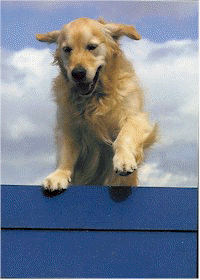 If
you're happy with your contacts, then don't mess with them. If you're not, you may want to
consider re-training them. But which method? There are as many contact techniques as there are
trainers - and they all have their merits. Iain Fraser has written a thought provoking article,
describing the three main strategies behind these methods and their implications for achieving
fast and accurate contacts. If
you're happy with your contacts, then don't mess with them. If you're not, you may want to
consider re-training them. But which method? There are as many contact techniques as there are
trainers - and they all have their merits. Iain Fraser has written a thought provoking article,
describing the three main strategies behind these methods and their implications for achieving
fast and accurate contacts.
There are probably
as many methods for working the contact obstacles as there are agility instructors.
Basically, they can be
placed into three broad
categories.
-
 Run
- The first approach is to ask the dog to run on and off the obstacle without stopping and to
either teach or trust her to touch the contact points on the way. Weíll call these running
contacts. Run
- The first approach is to ask the dog to run on and off the obstacle without stopping and to
either teach or trust her to touch the contact points on the way. Weíll call these running
contacts.
-
 Release
- The second approach is to teach the dog that whenever he attempts a contact obstacle he is
to run to some point at the end of the equipment where he should be touching the contact
point and to wait there until released (release methods). Release
- The second approach is to teach the dog that whenever he attempts a contact obstacle he is
to run to some point at the end of the equipment where he should be touching the contact
point and to wait there until released (release methods).
-
 Command
- Finally, the dog can be taught to stop or to find the contact point on command once she has
started performing the equipment (command methods). Command
- Finally, the dog can be taught to stop or to find the contact point on command once she has
started performing the equipment (command methods).
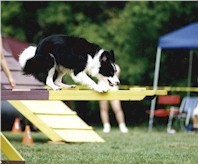 Which
do you do? Which
do you do?
Before you read the rest of this article, please take a few seconds to help us with our
research. Just let us know which method you usually use by clicking on one of the links below -
one for each dog you run. Please indicate whether or not you are happy with the results of your
method. We will publish a statistical summary of the responses.
-
I do running contacts
-
I release my dog
-
I command the contact
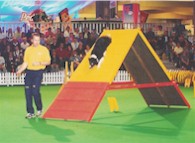 Usual
practice Usual
practice
Most agility instructors we speak to or read will advocate one of the first two methods.
However, based on our experience as judges and guest instructors, our impression is that one
variation or another on the command method is most commonly practiced. Whether it is verbal -
'you wait', 'find it', 'where is it?', 'get it') or physical like a hand signal, sudden stop,
blocking the end etc., most handlers in competition seem to rely on a last minute instruction
to the dog rather than a trained performance.
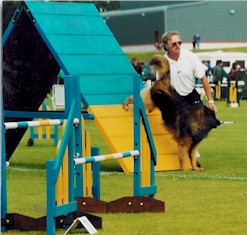 Is
it because this is proven to work? Is
it because this is proven to work?
Our impression from judging literally thousands of dogs is to the contrary. The answer to
'where is it' usually seems to be about three feet past the end of the dog walk! Dogs come to a
lovely stop right on command above the contact then jump off, or
suffer from a momentary deafness until they realise that 'Oh, of course you meant there
not here!' The reality is that the fraction of a second that it takes to negotiate the
end of the equipment is the worst possible time to try and synchronise dog and handler when
youíre both probably out of breath and position from running the rest of the round.
Historically,
running - perhaps more often, untrained - contacts were common. They fell from favour as
increasing speeds in competition led to a lower level of accuracy. The majority of the top UK
handlers moved to a release method of some sort. Just watch them hold their dogs that little
bit longer in the runs immediately before a major competition. Many others followed suit, with
or without an inadvertent stop command.
However in recent
years, driven largely by the success of some French competitors at the World Championships, a
few handlers in the UK and a number of top international handlers are training fast and
accurate running contacts. The two main techniques we have seen used involve either teaching
the dog to touch a target which later becomes a part of the contact area on the run, or else
teaching the dog to adjust its natural stride so that it always descends the equipment with a
predictable pattern going over the contact.
 The
name of the game is speed and accuracy The
name of the game is speed and accuracy
A fast dog walk is generally regarded as around two seconds from first paw on to first paw off.
Try timing the fastest dogs at your club. They have to be pretty
good to consistently hit the dog walk contacts in under 2.5 seconds. The fastest repeatable
times for running contacts are coming in at 1.6 to 1.8 seconds.
A high proportion
of dogs trained to release and command methods slow appreciably on the down plank as they
anticipate the stop and wait for the release and cannot hope to match these times.
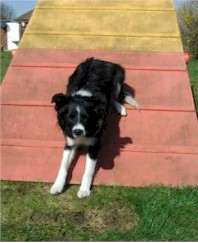 Why
do we teach a release method at Crazymaesy? Why
do we teach a release method at Crazymaesy?
Firstly, it is
consistency. We have a club full of dogs with fast and reliable contacts. So far we have seen
individual dogs trained to do good running contacts, but no evidence of a high and sustainable
success rate amongst a group with similar training.
Secondly, we arenít
yet seeing a competitive disadvantage, probably because we have always concentrated on speed,
motivation and independent performance as well as accuracy.
Contacts movie
clips
Look at the
movie clips of Joís Shark in action and see what you think,
bearing in mind that she isnít quite the
fastest dog in club. Recent stop watch timings - we need to set up electronic timing to be sure
- suggest that we are also getting times between 1.5 and 2 seconds with our faster dogs and 2
and 2.5 seconds with the rest.
But the rest of the
world is moving on, so look out for more blistering fast running contacts at this yearís World
Championships and pity the judges!
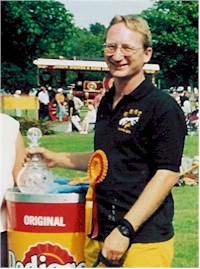 About
the author... About
the author...
Iain Fraser has been a leading competitor, judge and instructor for over ten
years. He and his wife Jo run Crazymaesy Agility and
instruct at White Horse Agility Training (WHAT).
Despite his
continuing success in Agility competitions, Iain probably has the least reliable contacts
of all the handlers at WHAT. He advises anyone seeking repeatable (rather than just fast)
contacts not to copy him but to listen to Jo instead!
|